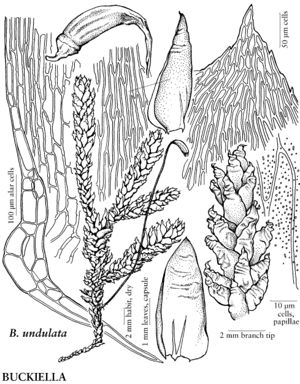Buckiella
Novon 11: 55, figs. 1, 2. 2001.
| Taxon | Illustrator ⠉ | |
|---|---|---|
 | Buckiella undulata | Patricia M. Eckel |
Plants large, in thin to loose mats, light green or whitish, sometimes yellowish, dull or somewhat glossy. Stems creeping or sometimes erect, sparingly and irregularly branched, occasionally simple; hyalodermis present, sometimes indistinct, central strand sometimes present; pseudoparaphyllia absent. Stem and branch leaves similar, imbricate, somewhat contorted, strongly undulate, especially near apex, ovate to ovatelanceolate, rarely oblong-lanceolate, not plicate; base weakly decurrent; margins plane, entire or usually serrulate to serrate at apex; apex acute to acuminate, rarely somewhat obtuse; costa double, ending just beyond base, rarely one branch reaching 1/3 leaf length; alar cells differentiated, rectangular; laminal cells papillose, papillae minute, granular, cuticular, much more abundant on abaxial surface. Specialized asexual reproduction absent. Sexual condition dioicous; perichaetial leaves narrowly ovate to oblong-lanceolate, apex acute to acuminate. Seta dark red, reddish, or light-brown. Capsule inclined to pendulous, cylindric, arcuate or sometimes straight, wrinkled and contracted below mouth when dry; annulus 1-seriate or 2-seriate, deciduous, cells large; operculum conic to rostrate; peristome double; exostome teeth with fine striations between lamellae proximally, papillose distally; endostome basal membrane rather high, segments broad, keeled, cilia 2 or 3, as long or nearly as long as segments. Calyptra naked. Spores globose to ovoid, smooth or minutely papillose.
Distribution
North America, Europe, Asia, Pacific Islands (Hawaii), Pacific Islands (New Guinea)
Discussion
Species 2 (1 in the flora).
Buckiella occurs in terrestrial habitats in temperate, boreal, and rarely tropical woods. Buckiella draytonii (Sullivant) Ireland is endemic to the Hawaiian Islands.
Selected References
None.
Lower Taxa
"broad" is not a number.